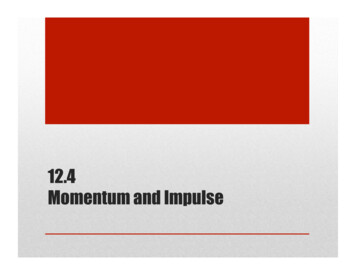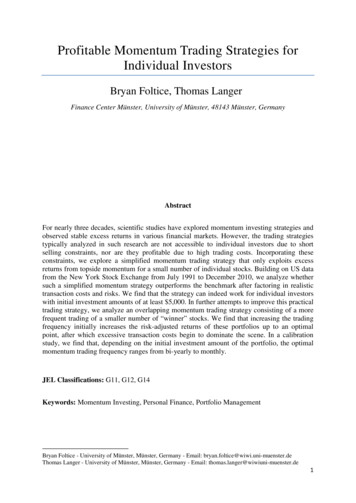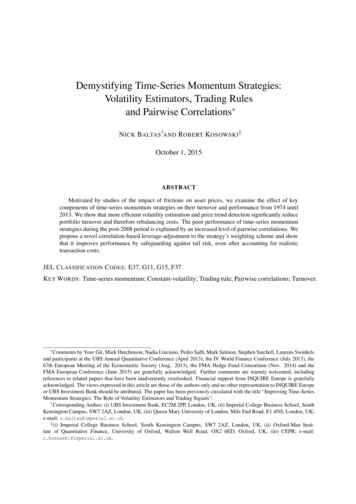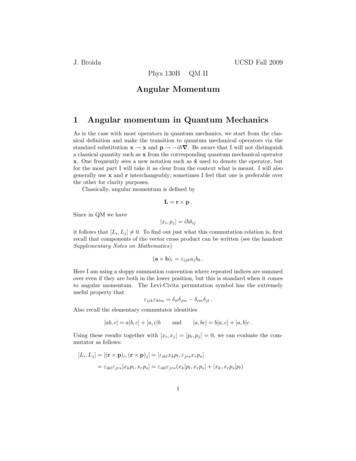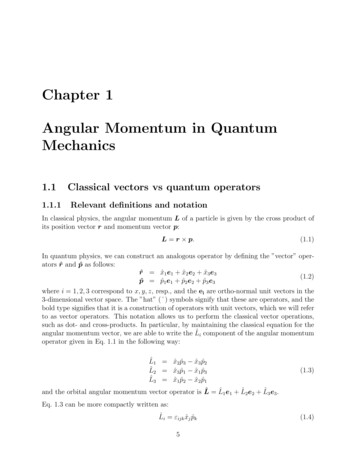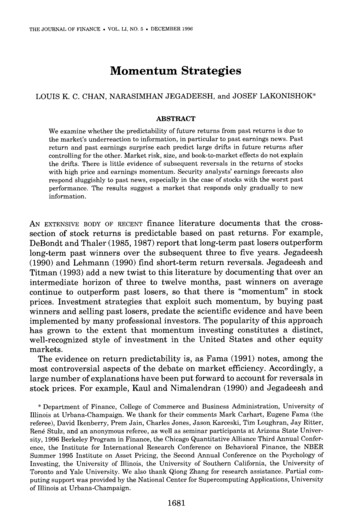
Transcription
THE JOURKAL O F FINANCEVOL. LI, NO 5.DECEMBER 1996Momentum StrategiesLOUIS K. C. CHAN, NARASIMHAN JEGADEESH, and JOSEF LAKONISHOKABSTRACTWe examine whether the predictability of future returns from past returns is due tothe market's underreaction to information, in particular to past earnings news. Pastreturn and past earnings surprise each predict large drifts in future returns aftercontrolling for the other. Market risk, size, and book-to-market effects do not explainthe drifts. There is little evidence of subsequent reversals in the returns of stockswith high price and earnings momentum. Security analysts' earnings forecasts alsorespond sluggishly to past news, especially in the case of stocks with the worst pastperformance. The results suggest a market that responds only gradually to newinformation.AN EXTENSIVE BODY OF RECENT finance literature documents that the crosssection of stock returns is predictable based on past returns. For example,DeBondt and Thaler (1985, 1987)report that long-term past losers outperformlong-term past winners over the subsequent three to five years. Jegadeesh(1990) and Lehmann (1990) find short-term return reversals. Jegadeesh andTitman (1993) add a new twist to this literature by documenting that over anintermediate horizon of three to twelve months, past winners on averagecontinue to outperform past losers, so that there is "momentum" in stockprices. Investment strategies that exploit such momentum, by buying pastwinners and selling past losers, predate the scientific evidence and have beenimplemented by many professional investors. The popularity of this approachhas grown to the extent that momentum investing constitutes a distinct,well-recognized style of investment in the United States and other equitymarkets.The evidence on return predictability is, as Fama (1991) notes, among themost controversial aspects of the debate on market efficiency. Accordingly, alarge number of explanations have been put forward to account for reversals instock prices. For example, Kaul and Nimalendran (1990) and Jegadeesh and* Department of Finance, College of Commerce and Business Administration, University ofIllinois at Urbana-Champaign. We thank for their comments Mark Carhart, Eugene Fama (thereferee), David Ikenberry, Prem Jain, Charles Jones, Jason Karceski, Tim Loughran, Jay Ritter,Ren6 Stulz, and an anonymous referee, as well as seminar participants a t Arizona State University, 1996 Berkeley Program in Finance, the Chicago Quantitative Alliance Third Annual Conference, the Institute for International Research Conference on Behavioral Finance, the NBERSummer 1995 Institute on Asset Pricing, the Second Annual Conference on the Psychology ofInvesting, the University of Illinois, the University of Southern California, the University ofToronto and Yale University. We also thank Qiong Zhang for research assistance. Partial computing support was provided by the National Center for Supercomputing Applications, Universityof Illinois a t Urbana-Champaign.
1682The Journal of FinanceTitman '(1995) examine whether bid-ask spreads can explain short-term reversals. Short-term contrarian profits may also be due to lead-lag effectsbetween stocks (Lo and MacKinlay (1990)).DeBondt and Thaler (1985, 1987),and Chopra, Lakonishok, and Ritter (1992) point to investors' tendencies tooverreact. Competing explanations for long-term reversals are based on microstructure biases that are particularly serious for low-priced stocks (Ball,Kothari, and Shanken (1995), Conrad and Kaul (1993)), or time-variation inexpected returns (Ball and Kothari (1989)). Since differences across stocks intheir past price performance tend to show up as differences in their book-tomarket value of equity and in related measures as well, the phenomenon oflong-term reversals is related to the kinds of book-to-market effects discussedby Chan, Hamao, and Lakonishok (1991), Fama and French (1992), andLakonishok, Shleifer, and Vishny (1994).The situation with respect to stock price momentum is very different. Incontrast to the rich array of testable hypotheses concerning long- and shortterm reversals, there is a woeful shortage of potential explanations for momentum. A recent article by Fama and French (1996) tries to rationalize anumber of related empirical regularities, but fails to account for the profitability of the Jegadeesh and Titman (1993) strategies. In the absence of anexplanation, the evidence on momentum stands out as a major unresolvedpuzzle. From the standpoint of investors, this state of affairs should also be asource of concern. The lack of an explanation suggests that there is a goodchance that a momentum strategy will not work out-of-sample and is merely astatistical fluke.The objective of this article is to trace the sources of the predictability offuture stock returns based on past returns. It is natural to look to earnings totry to understand movements in stock prices, so we explore this avenue torationalize the existence of momentum. In particular, this article relates theevidence on momentum in stock prices to the evidence on the market's underreaction to earnings-related information. For instance, Latane and Jones(1979), Bernard and Thomas (1989), and Bernard, Thomas, and Wahlen(1995), among others, find that firms reporting unexpectedly high earningsoutperform firms reporting unexpectedly poor earnings. The superior performance persists over a period of about six months after earnings announcements. Givoly and Lakonishok (1979) report similar sluggishness in the response of prices to revisions in analysts' forecasts of earnings. Accordingly, onepossibility is that the profitability of momentum strategies is entirely due tothe component of medium-horizon returns that is related to these earningsrelated news. If this explanation is true, then momentum strategies will not beprofitable after accounting for past innovations in earnings and earningsforecasts. Affleck-Graves and Mendenhall (1992) examine the Value Linetimeliness ranking system (a proprietary model based on a combination of pastearnings and price momentum, among other variables), and suggest thatearnings surprises account for Value Line's ability to predict future returns.Another possibility is that the profitability of momentum strategies stemsfrom overreaction induced by positive feedback trading strategies of the sort
Momentum Strategies1683discussed by DeLong, Shleifer, Summers, and Waldmann (1990). This explanation implies that "trend-chasers" reinforce movements in stock prices evenin the absence of fundamental information, so that the returns for past winners and losers are (at least partly) temporary in nature. Under this explanation, we expect that past winners and losers will subsequently experiencereversals in their stock prices.Finally, it is possible that strategies based either on past returns or onearnings surprises (we refer to the latter as "earnings momentum" strategies)exploit market under-reaction to different pieces of information. For example,an earnings momentum strategy may benefit from underreaction to information related to short-term earnings, while a price momentum strategy maybenefit from the market's slow response to a broader set of information,including longer-term profitability. In this case we would expect that each ofthe momentum strategies is individually successful, and that one effect is notsubsumed by the other. True economic earnings are imperfectly measured byaccounting numbers, so reported earnings may be currently low even thoughthe firm's prospects are improving. If the stock price incorporates other sourcesof information about future profitability, then there may be momentum instock prices even with weak reported earnings.In addition to relating the evidence on price momentum to that on earningsmomentum, this article adds to the existing literature in several ways. Weprovide a comprehensive analysis of different earnings momentum strategieson a common set of data. These strategies differ with respect to how earningssurprises are measured and each adds a different perspective. In the financeliterature, the most common way of measuring earnings surprises is in termsof standardized unexpected earnings, although this variable requires a modelof expected earnings and hence runs the risk of specification error. In comparison, analysts' forecasts of earnings have not been as widely used in the financeliterature, even though they provide a more direct measure of expectations andare available on a more timely basis. Tracking changes in analysts' forecasts isalso a popular technique used by investment managers. The abnormal returnssurrounding earnings announcements provide another means of objectivelycapturing the market's interpretation of earnings news. A particularly intriguing puzzle in this regard is that Foster, Olsen, and Shevlin (1984) find thatwhile standardized unexpected earnings help to predict future returns, residual returns immediately around the announcement date have no such power.Our analysis helps to clear up some of these lingering issues on earningsmomentum. We go on to confront the performance of price momentum withearnings momentum strategies, using portfolios formed on the basis of oneway, as well as two-way, classifications. These comparisons, and our crosssectional regressions, help to disentangle the relative predictive power of pastreturns and earnings surprises for future returns. We also provide evidence onthe risk-adjusted performance of the price and earnings momentum strategies.We confirm that drifts in future returns over the next six and twelve monthsare predictable from a stock's prior return and from prior news about earnings.Each momentum variable has separate explanatory power for future returns,
1684The Journal of Financeso one strategy does not subsume the other. There is little sign of subsequent,reversals in returns, suggesting that positive feedback trading cannot accountfor the profitability of momentum strategies. If anything, the returns forcompanies that are ranked lowest by past earnings surprise are persistentlybelow average in the following two to three years. Security analysts' forecastsof earnings are also slow to incorporate past earnings news, especially for firmswith the worst past earnings performance. The bulk of the evidence thus pointsto a delayed reaction of stock,prices to the information in past returns and inpast earnings.The remainder of the article is organized as follows. Section I describes thesample and our methodology. Univariate analyses of our different momentumstrategies are carried out in Section 11, while the results from multivariateanalyses are reported in Section 111. Section IV examines whether price andearnings momentum are subsequently corrected. Section V checks that ourresults are robust by replicating the results for larger companies only, and bycontrolling for risk factors. Section VI concludes.I. Sample and MethodologyWe consider all domestic, primary stocks listed on the New York (NYSE),American (AMEX), and Nasdaq stock markets. Closed-end funds, Real EstateInvestment Trusts (REITs), trusts, American Depository Receipts (ADRs),andforeign stocks are excluded from the analysis. Since we require information onearnings, the sample comprises all companies with coverage on both theCenter for Research in Security Prices (CRSP) and COMPUSTAT (Active andResearch) files. The data for firms in this sample are supplemented, whereveravailable, with data on analysts' forecasts of earnings from the Lynch, Jones,and Ryan Institutional Brokers Estimate System (I/B/E/S) database.At the beginning of every month from January 1977 to January 1993, werank stocks on the basis of either past returns or a measure of earnings news.To be eligible, a stock need only have data available on the variable(s) used forranking, even though we provide information on other stock attributes. Theranked stocks are then assigned to one of ten decile portfolios, where thebreakpoints are based only on NYSE stocks. In our earnings momentumstrategies, the breakpoints in any given month are based on all NYSE firmsthat have reported earnings within the prior three months. This takes intoaccount a complete cycle of earnings announcements. All stocks are equallyweighted within a given portfolio.The ranking variable used in our price momentum strategy is a stock's pastcompound return, extending back six months prior to portfolio formation. Inour earnings momentum strategies, we use three different measures of earnings news. Our first is the commonly used standardized unexpected earnings(SUE) variable. Foster, Olsen, and Shevlin (1984) examine different timeseries models for expected earnings and how the resulting measures of unanticipated earnings are associated with future returns. They find that a seasonal random walk model performs as well as more complex models, so we use
Momentum Strategies1685it as our model of expected earnings. The SUE for stock i in month t is thusdefined aswhere eiq is quarterly earnings per share most recently announced as of montht for stock i , eiq-, is earnings per share four quarters ago, and Fit is thestandard deviation of unexpected earnings, eiq - e,,-,, over the precedingeight quarters.Another measure of earnings surprise is the cumulative abnormal stockreturn around the most recent announcement date of earnings up to month t ,ABR, defined aswhere rij is stock i's return on dayj (with the earnings being announced on day0) and rmj is the return on the equally-weighted market index. We cumulatereturns until one day after the announcement date to account for the possibility of delayed stock price reaction to earnings news, particularly since oursample includes Nasdaq issues that may be less frequently traded. Thisreturn-based measure is a fairly clean measure of earnings surprise, since itdoes not require an explicit model for earnings expectations. However, theabnormal return around the announcement captures the change over a window of only a few days in the market's views about earnings. The SUE measureincorporates the information up to the last quarter's earnings and hence inprinciple measures earnings surprise over a longer period.Our final measure of earnings news is given by changes in analysts' forecastsof earnings. Since analyst estimates are not necessarily revised every month,many of the monthly revisions take the value of zero. To get around this, wedefine REV6, a six-month moving average of past changes in earnings forecasts by analysts:where fit is the consensus (mean) I/B/E/S estimate in month t of firm i'searnings for the current fiscal year (FYI). The monthly revisions in estimatesare scaled by the prior month's stock price.l Analyst estimates are available onScaling the revisions by the stock price penalizes stocks with high price-earnings ratios. Tocircumvent this possibility, we also scaled revisions by the book value per share. We also experimented with the percent change in the median I/B/E/S estimate, as well as the difference between
The Journal of Financea monthly basis2 and dispense with the need for a model of expected earnings.-However,the estimates issued by analysts may be colored by other incentivessuch as the desire to encourage investors to trade and hence generate brokerage commissions.3 As a result, analyst forecasts may not be a clean measure ofexpected earnings.For each of our momentum strategies, we report buy-and-hold returns in theperiods subsequent to portfolio formation. Returns measured over contiguousintervals may be spuriously related due to bid-ask bounce, thereby attenuatingthe performance of the price momentum strategy. To control for this effect, weskip the first five days after portfolio formation before we begin to measurereturns under the price momentum strategy and, for the sake of comparability,under the earnings momentum strategy as well. If a stock is delisted after it isincluded in a portfolio but before the end of the holding period over whichreturns are calculated, we replace its return until the end of the period withthe return on a value-weighted market index. At the end of the period werebalance all the remaining stocks in the original portfolio to equal weights inorder to calculate returns in subsequent periods. In addition to returns on theportfolios, we also report two attributes of our portfolios-the book-to-marketvalue of equity and the ratio of cash flow (earnings plus depreciation) toprice-at the time of portfolio formation. Finally, we also track our threemeasures of earnings surprise (SUE, ABR, and REVG) at the time of portfolioformation and thereafter.11. Price and Earnings Momentum: Univariate AnalysisA. Price MomentumWe first examine the ability of each of the momentum strategies to predictfuture returns, and the characteristics of the momentum portfolios. To lay thegroundwork, Table I reports correlations between the various measures we useto group stocks into portfolios. The correlations are based on monthly observations pooled across all stocks. Although the variables are positively correlated with one another, the coefficients are not large. In particular, the differthe number of upward and downward revisions as a proportion of the number of estimates. Ourresults are robust to these alternative measures of analyst revisions.In the context of an implementable investment strategy, all stocks are candidates for inclusionin our price momentum or earnings momentum portfolios in a given month. The strategy based onanalyst revisions automatically fulfills this requirement, since consensus estimates are availablea t a monthly frequency. The portfolios based on standardized unexpected earnings and abnormalannouncement returns will pick up an earnings variable that may be somewhat out-of-date forthose firms not announcing earnings in the month of portfolio formation. This may lead to anunderstatement of the returns to these two earnings momentum strategies, but in any event weare able to compare directly the results from the price momentum and from the earnings momentum strategies.Several recent examples of these kinds of pressures on analysts are described by MichaelSiconolfi in "A rare glimpse a t how Wall Street covers clients," Wall Street Journal, July 14, 1995,and "Incredible buys: Many companies press analysts to steer clear of negative ratings," WallStreet Journal, July 19, 1995.
Momentum Strategies1687Table ICorrelations Between Prior Six-Month Return and Past EarningsSurprisesCorrelation coefficients are calculated over all months and over all stocks for the followingvariables. R6 is a stock's compound return over the prior six months. SUE is unexpected earnings(the change in the most recent past quarterly earnings per share from its value four quarters ago),scaled by the standard deviation of unexpected earnings over the past eight quarters. REV6 is amoving average of the past six months' revisions in Institutional Brokers Estimate System(I/B/E/S) median analyst earnings forecasts relative to beginning-of-month stock price. ABR is theabnormal return relative to the equally-weighted market index cumulated from two days before toone day after the most recent past announcement date of quarterly earnings. The sample includesall domestic primary firms on New York Stock Exchange (NYSE), American Stock Exchange(AMEX), and Nasdaq with coverage on the Center for Research in Security Prices (CRSP) andCOMPUSTAT. The data extend from January 1977 to December 1993.R6SUEABRREV6R6SUEABRREV6ent measures of earnings surprises are not strongly associated with each other.The highest correlation (0.440) is between standardized unexpected earningsand revisions in analyst forecasts, while the correlation between analyst revisions and abnormal returns around earnings announcements is 0.115. The lowcorrelations suggest that the different momentum variables are not entirelybased on the same information. Rather, they capture different aspects ofimprovement or deterioration in a company's performance.Panel A of Table I1 documents the stock price performance of portfoliosformed on the basis of prior six-month returns, where portfolio 1 comprisespast "losers" and portfolio 10 comprises past "winners." Subsequent to theportfolio formation date, winners outperform losers, so that by the end oftwelve months there is a large difference of 15.4 percent between the returnsof the winner and loser portfolios. This difference is driven by the extremedecile portfolios, however. Comparing the returns on decile portfolios 9 and 2reveals a smaller difference of 6.3 percent.While there is prior evidence on the profitability of price momentum strategies, we go further and provide additional characteristics of the differentportfolios. In Panel B, there is a fairly close association between past returnperformance and the portfolios' book-to-market ratios (measured as of theportfolio formation date). The portfolio of past winners tends to include "glamour" stocks with low book-to-market ratios. Conversely, the portfolio of pastlosers tends to include "value" stocks with high book-to-market ratios. This isnot necessarily surprising, however. Even if the different portfolios had similarbook-to-market ratios a t the beginning of the period, book values change veryslowly over time but one portfolio rose in market value by 70 percent while theother fell by 31 percent. However, the ten portfolios display smaller differences
The Journal of FinanceTable I1Mean Returns and Characteristics for Portfolios Classified by PriorSix-Month ReturnAt the beginning of every month from January 1977 to January 1993, all stocks are ranked by theircompound return over the prior six months and assigned to one of ten portfolios. The assignmentuses breakpoints based on New York Stock Exchange (NYSE) issues only. All stocks are equallyweighted in a portfolio. The sample includes all NYSE, American Stock Exchange (AMEX), andNasdaq domestic primary issues wlth coverage on the Center for Research in Security Prices(CRSP) and COMPUSTAT. Panel A reports the average past six-month return for each portfolio,and buy-and-hold returns over periods following portfolio formation (in the following six monthsand in the first, second, and third subsequent years). Panel B reports accounting characteristicsfor each portfolio: book value of common equity relative to market value, and cash flow (earningsplus depreciation) relative to market value. Panel C reports each portfolio's most recent past andsubsequent values of quarterly standardized unexpected earnings (the change in quarterly earnings per share from its value four quarters ago, divided by the standard deviation of unexpectedearnings over the last eight quarters). Panel D reports abnormal returns around earnings announcement dates. Abnormal returns are relative to the equally-weighted market index and arecumulated from two days before to one day after the date of earnings announcement. In Panel E,averages of percentage revisions relative to the beginning-of-month stock price in monthly meanI B / E / S estimates of current fiscal-year earnings per share are reported.1(Low)23678910(High)0.000 0.0500.096 0.1490.208 0.2140.2220.2230.2350.2480.2970.206 0.2080.2080.2040.2080.2070.1990.196 0.6700.7440.8240.91945Panel A. ReturnsPast6-monthreturn-0.308 -0.126 0 . 0 5 5Return6monthsafter0.061 0.086 0.093portfolio formation0.143 0.185 0.198Return first year afterportfolio formationReturn second year after 0.205 0.201 0.205portfolio formation0.194 0.196 0.197Returnthirdyearafterportfolio formationPanel B: CharacteristicsBook-to-market 650.1490.943 0.9160.152 0.151Panel C: Standardized Unexpected EarningsMost recent quarterNext quarter-0.879 -0.336 -0.092-1.052 -0.414 0 . 1 4 70.046 0.1960.034 0.1920.3160.350Panel D: Abnormal Return Around Earnings AnnouncementsMost recent-0.027 -0.013 0 . 0 0 7 1 0 . 0 0 4 -0.001portfolio formationSecondannouncement-0.0020.000 0.000 0.001after portfolioformation0.002 0.001 0.002 0.001Third announcementafter portfolioformation0.003 0.001 0.002 0.001Fourthannouncementafter 0010.0020.0010.001
Momentum Strategies1689Table 11-Continued1(Low)2345678910(High)Panel E: Revision in Analyst Forecasts (55)Most recent revisionAverage over next 6monthsAverage from months 7to 122 . 1 9 0 -0.576 -0.401 -0.262 -0.212 -0.127 -0.129 -0.0282 . 1 3 8 0 . 5 7 8 0 . 3 6 8 0 . 2 8 2 0 . 2 2 0 0 . 1 5 2 -0.117 -0.068-0.0030.0410.0860.004-1.843 -0.555 0 . 3 7 8 0 . 3 1 8 0 . 2 4 8 0 . 2 0 6 -0.191 0 . 1 6 5 0 . 1 5 3 0 . 1 8 0with respect to their ratios of cash flow to price. The extreme portfolios featurelow ratios of cash flow to price, but for different reasons. The portfolio of pastlosers contains stocks with relatively depressed past earnings and cash flow,while the portfolio of past winners contains glamour stocks that have done wellin the past.The last three panels of Table I1 provide clues as to what may be drivingprice momentum. Perhaps not surprisingly, the past price performance of theportfolios is closely aligned with their past earnings performance. There is alarge difference between the past winners and past losers in terms of theinnovation in their past quarterly earnings (Panel C). Past abnormal announcement returns (Panel D) also rise across the momentum portfolios, witha large difference (6.2 percent) between portfolios ten and one. Stocks thathave experienced high (low) past returns are associated with large upward(downward) past revisions in analysts' estimates (Panel E).4More remarkably, the differences across the portfolios in their past earningsperformance continue over the periods following portfolio formation. Thespread between the SUES of the winner and loser portfolios is actually widerin the following quarter. This may simply be a symptom of a misspecifiedmodel of expected earnings,5 so examining the behavior of returns aroundearnings announcement dates provides a more direct piece of evidence. We findthat the market continues to be caught by surprise a t the two quarterlyearnings announcements following portfolio formation, particularly for theextreme decile portfolios.6 In particular, the abnormal return around the firstsubsequent announcement is higher by 2.6 percent for winner stocks comparedNote that in Panel E we report statistics for monthly percentage revisions in the consensusestimates (while portfolios are formed on the basis of a six-month moving average of revisions).The presence of reporting delays in the individual estimates underlying the consensus may induceapparent persistence on a month-by-month basis, so we report average percent changes over thefirst and second six-month periods following portfolio formation.Fama and French (1993, 1995) argue that the statistical process for earnings changed duringthe 1980s. It might be suggested that this prolonged period of continuous rational surprises couldaccount for part of the earnings surprise effects in returns. On the other hand, numerous studiesdocument the existence of earnings surprise effects before the start of our sample period. See, forexample, Givoly and Lakonishok (19791, Jones and Litzenberger (19701, and Latane and Jones(1979).Note that the average abnormal return around announcement dates is positive. This isconsistent with the findings of Chari, Jagannathan, and Ofer (1988).
1690The Journal of Financeto loser stocks. In the second announcement following portfolio formation, theabnormal return is again larger for winner stocks by 1 percent. To put this inperspective, the spread in returns between portfolios 10 and 1is 8.8 percent inthe first six months after portfolio formation. The combined difference of 3.6percent in abnormal returns around the subsequent two announcements ofquarterly earnings thus accounts for 41 percent of this spread. After twoquarters, there is not much difference between the portfolios' abnormal returns around earnings announcements.Panel E examines the behavior of analysts' revisions in earnings forecasts.The revisions across all the portfolios are mostly negative, a finding consistentwith the notion that analysts' forecasts initially tend to be overly optimisticand are then adjusted downward over time. Such optimism may reflect theincentives faced by analysts. In particular, analysts' original estimates may beoverly favorable in order to encourage investors to buy a stock and hencegenerate brokerage income. There are more potential buyers (all the clients ofthe brokerage firm) than potential sellers (who are limited to current holdersof the stock, given the difficulty of short-selling). Hence an analyst is less likelyto benefit from issuing a negative recommendation. An unfavorable forecastmay damage relations between management and the analyst, and jeopardizeother relations between management and the brokerage firm (such as underwriting and investment banking).In the period following portfolio formation, revisions for the loser portfolioare relatively unfavorable, while those for the winner portfolio are relativelyfavorable. The adjustments in forecasts are especially protracted for the loserportfolio, as there is a large downward monthly revision averaging 2.1 percent(relative to the stock price at the beginning of the month) in the first sixmonths after portfolio formation. The average monthly revision from seven totwelve months afterwards is still large (1.8 percent). Klein (1990) also findsthat analysts remain overly optimistic in their forecasts for f
Short-term contrarian profits may also be due to lead-lag effects between stocks (Lo and MacKinlay (1990)). . chance that a momentum strategy will not work out-of-sample and is merely a . from overreaction induced by positive feedback trading strategies of the sort . Momentum Strategies
